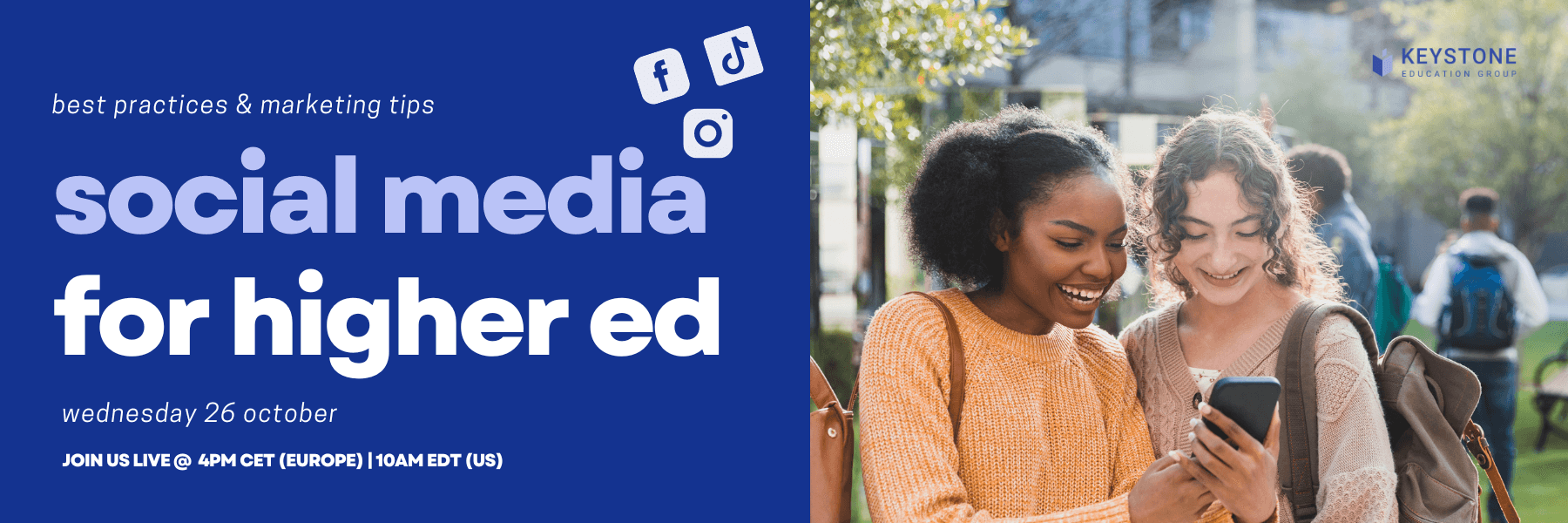- SERVICES
- HIGHER EDUCATION MARKETING
- ENGAGEMENT & ENROLLMENT MANAGEMENT
- STUDENT RECRUITMENT AGENCIES
- PROFESSIONAL EDUCATION & TRAINING
- WHO WE ARE
WHO WE ARE
Learn more about Keystone Education Group, including our leadership structure, why choose Keystone as your educational partner, and company press releases.
QUICK LINKS
- RESOURCES
RESOURCES
Find a range of helpful resources to help with your educational marketing. From on-demand webinars, reports & data, to customer testimonials and our downloadable media kit.
QUICK LINKS
- NEWS
- REQUEST A CALL

- Keystone Higher Education News
- Do hashtags still work?
It’s been over a decade since hashtags were first introduced. One of the world's most recognizable symbols first made its debut on Twitter in 2007, and then later on Instagram in 2011. As on Twitter, Instagram hashtags were introduced to organize and categorize photo and video content, allowing the content of organizations, brands and individuals alike to be discovered worldwide. However, with the Instagram algorithm continually changing as popularity of the platform picks up speed, the question remains - do hashtags still work?
The short answer is yes. While younger social media users may argue that usage of hashtags is perhaps not as "cool" as earlier generations who embraced them, they still are highly effective social media tools. In fact, Instagram is continually optimizing how hashtags are used for improved user experience. However, what has changed is the competition and evolving generational preferences. As more users flood to the platform, more and more are leveraging the power of hashtags. The same goes for colleges and universities, with more marketing departments than ever harnessing the power of social media. For that reason, your college or university may want to optimize your content to make sure that your hashtags are being used in the best possible way. Let’s #investigate how you can do that.
Which hashtags should you use?
One of the most common mistakes that can be made when it comes to hashtags is usage of general categories like #college #collegelife or #collegefootball. If you’re using hashtags like this, it makes it difficult to compete because these hashtags have over a million posts associated with them, and your post will get likely be lost in the depths. Secondly, these hashtags don’t reveal anything unique about your college. Thirdly, put yourself in your students’ shoes. It’s very unlikely that your students are going to be scrolling through generic #college or #university hashtags.
Instead, you should aim to be specific with your hashtags so you can put your college in front of current or prospective students where they are. Think about the kind of hashtags your students would be using or interested in. They could be looking through the hashtag for your football team, or they might be searching through location tags in your local area.
There are also free hashtag tools available online that can help you figure out the best hashtags for the content you’re promoting. The website Hashtagify.me is helpful for finding popular hashtags. For example, you can search the hashtag #collegefootball and Hashtagify.me will show you alternative hashtags for this topic. You can then look at those hashtags and see how popular they are to determine whether they would be a good fit.
WATCH ON DEMAND WEBINAR:
Use hashtags that describe your post
Another common mistake marketers make when using hashtags is that they use the same hashtags on every post. This is something you should avoid. Instagram’s community guidelines clearly outline that “posting repetitive comments or content” is seen as spam. Keep track of how frequently you use the same hashtags and mix it up as often as you can.
When you create a post, only use hashtags that make sense in the context of the post. If you tag a post with #smythsoncollege, for example, your content must be something "Smythson College" students will want to comment on, like, and share.
Remember, using hashtags is not about being seen by everyone or amassing the greatest number of likes. Using hashtags is about getting the attention of the right people and creating a conversation with them. That’s how hashtags lead to higher engagement and loyal followers. It may take some time, but it is worth it.
Create your own hashtag
While there are plenty of hashtags you can use, you can also create your own hashtag from scratch. This has a lot of benefits! Your own hashtag will give you a greater ability to engage with your students and it will also be a great organic marketing resource.
For example, the College of Charleston uses the hashtag #CofC and puts it in its Instagram bio so everyone can see what it is. They have also created unique hashtags for their sporting teams, like #cofcsports.
University College London uses the hashtag #loveucl and includes the blurb “Tag your snapshots of life at UCL with #loveucl” in their Instagram bio to encourage students to share.
Both of these colleges use their unique hashtag in their own posts, and they encourage their students to use the hashtags when posting about the college. This creates a virtual community that their students can be a part of. This also works as an organic marketing tool, as prospective students will see their friends sharing about their experiences at the college, and may want to learn more.
Use hashtags and location tags in Stories
Just like you can add hashtags and location tags to your Instagram posts, you should also include them in Instagram Stories. By doing so, you allow your college’s Stories to appear in that hashtag’s Stories or in the top Stories for that particular location. One simple way to do this is to always use the location tag of your college. If your college is in Seattle, use the location “Seattle,” or if your college is in Boston, use the location “Boston.”
Engage in the hashtags
As a marketer, it can be tempting to simply share a post on Instagram and then get out of the app altogether. However, you should make the most of your hashtags by engaging with the other posts that use the hashtags. You can do this by following users and by commenting on and liking their posts. This will help you build a relationship with current or prospective students, and most importantly, will build brand awareness.
Get started!
If you haven’t already started harnessing the power of hashtags, it is time to begin. You cannot afford to miss out on this powerful (and free!) way to get your college or university in front of the right people. Just one hashtag could have a huge impact on your brand. If you use hashtags correctly, following the steps above, you’ll likely begin to see how hashtags can play an important role in your college marketing strategy. Time to get started!
Related Tags
Just For You
Top Picks
Higher Ed Chats Podcast
Listen to the latest episodes of our Higher Ed Chats Podcast. Hear from Higher Ed thought-leaders from around the world!
WATCH: State of Student Recruitment 2025

Watch the on-demand webinar to see the findings of the 2025 State of Student Recruitment Report
Subscribe
to get the latest news and updates






